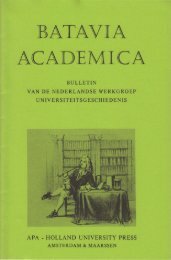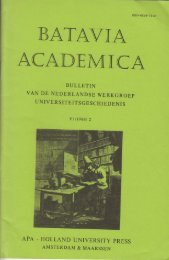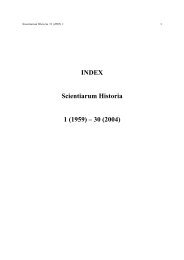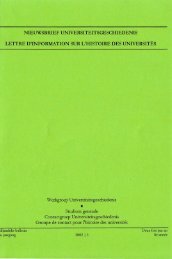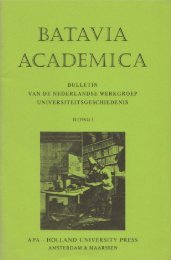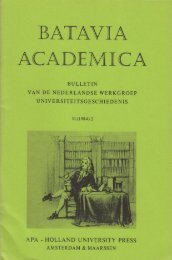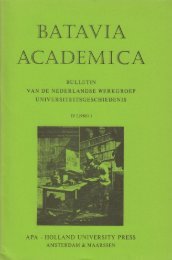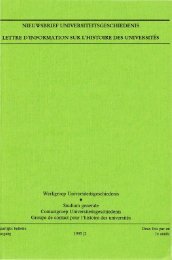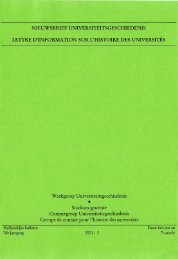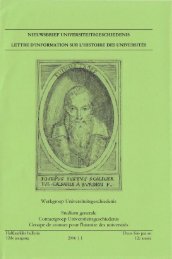the ocular harpsichord of louis-bertrand castel - Gewina
the ocular harpsichord of louis-bertrand castel - Gewina
the ocular harpsichord of louis-bertrand castel - Gewina
Create successful ePaper yourself
Turn your PDF publications into a flip-book with our unique Google optimized e-Paper software.
Castel's oculcU" <strong>harpsichord</strong> 65<br />
greatly influenced by Heinse; he urged his friend Wackenroder to read Ardinghello.^^<br />
In Tieck's work synaes<strong>the</strong>tic imagery appears in full bloom. In his<br />
poem Zerbino, written 1796-1798 and published in 1799, one reads: "What by<br />
order <strong>of</strong> <strong>the</strong> gods had been jealously separated, here <strong>the</strong> goddess Fantasy has<br />
united, having <strong>the</strong> sounds know <strong>the</strong>ir colours, causing sweet voices to shine<br />
through <strong>the</strong> leaves and making colour, scent and song call each o<strong>the</strong>r sisters.""'<br />
But in <strong>the</strong> Phantasien iiber die Kunst, which reads like a programme <strong>of</strong><br />
a new Romantic aes<strong>the</strong>tics and was largely written by Wackenroder but expanded<br />
and published under his own name by Tieck, earlier objections against a<br />
full analogy between painting and music, raised earlier by, for instance, Rousseau,<br />
were taken up once again: painting cannot but imitate, and in this it is<br />
necessarily very close to nature, but at <strong>the</strong> same time it will always fall short <strong>of</strong><br />
nature's own beauty. Music, on <strong>the</strong> o<strong>the</strong>r hand, is <strong>the</strong> essentially human, creative<br />
art. Therefore <strong>the</strong> evocative power <strong>of</strong> music is much greater than <strong>the</strong> power <strong>of</strong><br />
colours.'^ Notwithstanding this asymmetry, however, Tieck engorged <strong>the</strong><br />
sensory abundance <strong>of</strong> nature, agreeing with Castel that a even a single colour<br />
delights us, and he fully endorsed <strong>the</strong> use <strong>of</strong> synaes<strong>the</strong>tic imagery, although he<br />
did not justify it in any systematical way:<br />
The variety among flowers and shrubs is an arbitrary music in beautiful interplay, in sweet<br />
repetition: <strong>the</strong> songs <strong>of</strong> <strong>the</strong> birds, <strong>the</strong> gurgling <strong>of</strong> <strong>the</strong> water, <strong>the</strong> cries <strong>of</strong> <strong>the</strong> animals are in a<br />
sense at <strong>the</strong> same time an orchard or flower garden: <strong>the</strong> most charming love and friendship<br />
winds itself with glittering chains around all forms, colours and tones inseparable.'"<br />
'"" See ibid., p. 514.<br />
Cited in ibid., pp. 521-522: "Was neidsch sonst der Goiter SchluB getrennet, / Hat Gottin<br />
Phantasie allhier vereint, / So daB der Klang hier seine Farbe kennet, / Durch jedes Blatt die siiBe<br />
Stimme scheint, / Sich Farbe, Duft, Gesang, Geschwister nennet."<br />
'^ Tieck [and Wackenroder], Phantasien, esp. pp. 119-121, 240-245.<br />
137<br />
Ibid., p. 118: "Die Mannigfaltigkeit in Blumen und Gestrauchen ist eine willkiihrliche Musik<br />
im schonen Wechsel, in lieber Wiederholung: die Gesange der Vogel, der Klang der Gewasser, das<br />
Geschrey der Thiere ist gleichsam wieder ein Baum- und Blumengarten: die lieblichste Freundschaft<br />
und Liebe schlingt sich in glanzenden Fesseln um alle Gestalten, Farben und Tone unzertrennlich."<br />
Tieck did try to establish something <strong>of</strong> a formal analogy between colours and sounds,<br />
though. He rejected <strong>the</strong> elementary analogy <strong>of</strong> <strong>the</strong> <strong>ocular</strong> <strong>harpsichord</strong> as he had come to know it,<br />
but proposed instead an analogy not between single colours and tones but between <strong>the</strong> different<br />
shades <strong>of</strong> one colour and different tones. The single colours <strong>the</strong>mselves had to be seen not as <strong>the</strong><br />
analogues <strong>of</strong> single tones but <strong>of</strong> timbres or instruments. In this, Tieck repeated an interpretation<br />
that had been suggested already a couple <strong>of</strong> times before. The French printer Gauthier d'Agoty,<br />
one <strong>of</strong> <strong>the</strong> first printers to produce three-colour prints, had thought along <strong>the</strong>se lines in 1753, and<br />
<strong>the</strong> German Hellwag had written an article about it in 1786 and even presented <strong>the</strong> idea to Kant.<br />
The one to have elaborated this idea <strong>the</strong> far<strong>the</strong>st was <strong>the</strong> German Johann Leonhard H<strong>of</strong>fmann, in<br />
his book Versuch einer Geschicfue der mahlerischen Harmonic iiberhaupt und der Farbenharmonie<br />
insbesondere, published in 1786. H<strong>of</strong>fmann even gave a list <strong>of</strong> all <strong>the</strong> different analogues <strong>of</strong> colours<br />
and instrument, coupling indigo to <strong>the</strong> violoncello, blue to <strong>the</strong> violin, green to <strong>the</strong> human voice,



